Motorola Droid RAZR Review - A Better Clad Bionic
by Brian Klug on December 16, 2011 2:01 AM EST- Posted in
- Smartphones
- Droid
- LTE
- 4G
- Motorola
- Android
- Mobile
- Droid RAZR
- motorola droid RAZR
Cellular Connectivity
We’ve already outlined much of what there is to say about the combination of Qualcomm’s MDM6600 and Motorola’s on Wrigley LTE baseband inside the Droid Bionic review, but it still bears going over. Just like the Bionic, MDM6600 handles 1x voice and data, EVDO Rev.A 3G data, and Wrigley supplies LTE connectivity. In fact, the RAZR has a virtually identical cellular architecture to the Bionic, at least as far as I can tell. There’s the same Infineon transciever for LTE, Skyworks 700 MHz power amp, and combination MCP DRAM+NAND packages for the MDM6600 and Wrigley basebands.
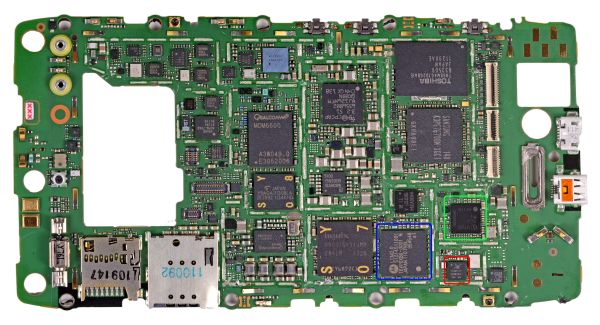
Motorola Wrigley LTE baseband, Intel/Infineon transceiver, Skyworks PA encircled in blue, green, and red respectively. (Original image courtesy iFixit)
I wasn’t totally satisfied in the Bionic piece that I proved the Wrigley baseband was UE Category 2, so I did some more poking this time with the RAZR and found the same exact architecture for administration and configuration as previously. Wrigley is actually a very interesting little part, consisting of an ARM926EJ-S running at 380 MHz:
cat /proc/cpuinfoProcessor : ARM926EJ-S rev 5 (v5l)BogoMIPS : 189.57Features : swp half thumb fastmult edsp javaCPU implementer : 0x41CPU architecture: 5TEJCPU variant : 0x0CPU part : 0x926CPU revision : 5Hardware : Wrigley 3G DatacardLTE
Oddly enough there are many places where it refers to itself as a “3G Datacard” even though it’s clearly designed only to work with LTE. The thing is just running GNU Linux:
uname -aLinux localhost 2.6.29-omap1 #2 Tue Oct 25 20:02:46 CDT 2011 armv5tejl GNU/Linux
The reality is that almost all black boxes inside mobile phones end up revealing something similar at their heart if you poke around enough. If we were counting the number of ARM parts onboard your average smartphone I wouldn’t be surprised to see at least 4 or 5 different ARM cores.
Anyhow, the RAZR doesn’t have a nice mib default xml file that nicely spells out the LTE UE category like the Bionic did, but the default set of mibs being set does include the Verizon EARFCN of 5230 which corresponds to LTE band 13. After lots of poking around, I found a way to query the UE category directly:
shell@(unknown):/system/bin$ iwaconfig -g -x 33163MOID 0x818b Name LTE_MGMT_RRC_UE_CATEGORY MIB OIDvalue=2 [0x02]
So life is good and our earlier claims that Motorola Wrigley (with lots of TI references inside) is indeed LTE UE Category 2. As a reminder, other devices based on MDM9x00, LG L2000, and Samsung’s CMC220 are UE Category 3.
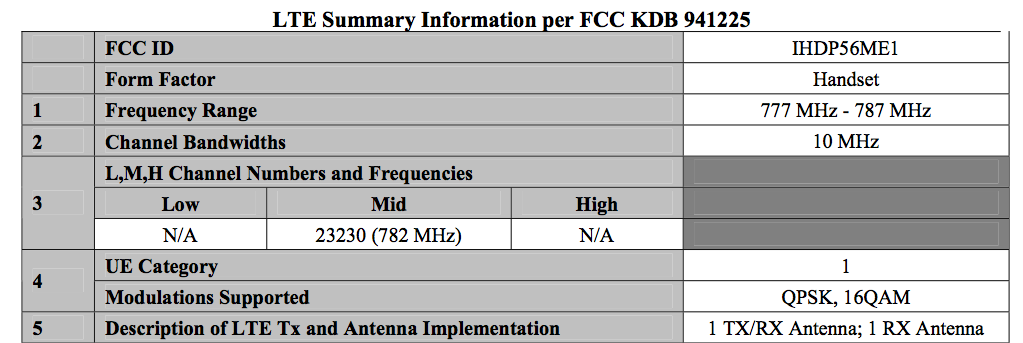
Oddly enough, just like the Bionic the official FCC filing summary information for the LTE side of the RAZR erroneously states that it is UE Category 1. As usual we get the normal pretty diagram with the location of antennas, and interestingly enough the LTE antenna is up at the top on the RAZR instead of in a combined module at the very bottom.
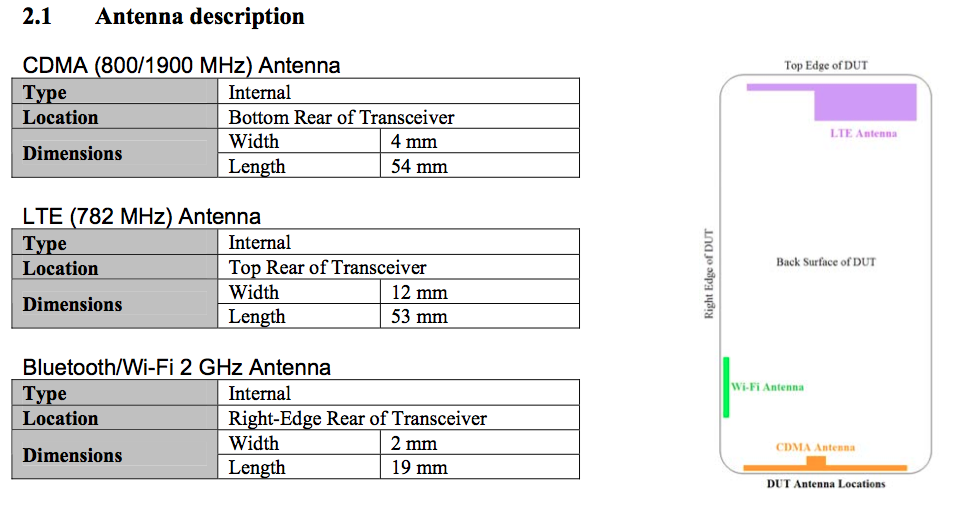
We’ve been doing a pretty good job keeping track of cellular throughput by running a bunch of speedtests, getting that data off, and making some graphs. The RAZR isn’t spared this treatment at all, and I ran 510 tests on Verizon 4G LTE in my own market in Tucson AZ and while on a trip to Los Angeles, CA.
Downstream Stats (Mbps)Avg: 14.701; Max: 36.267; Min: 0.068, StDev: 6.594Upstream Stats (Mbps)Avg: 6.912; Max: 20.719; Min: 0.084, StDev: 3.707Latency Stats (ms)Avg: 80.990; Max: 196; Min: 34, StDev: 17.499
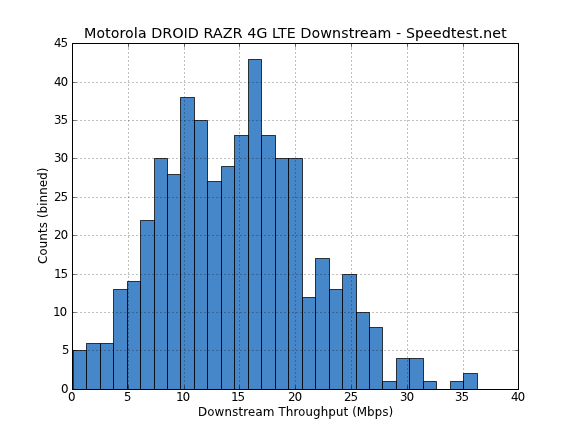
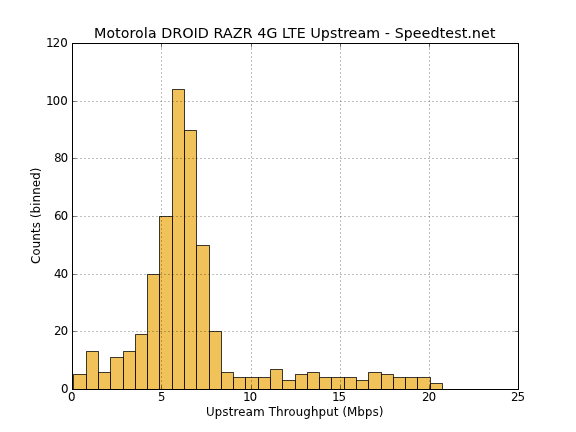
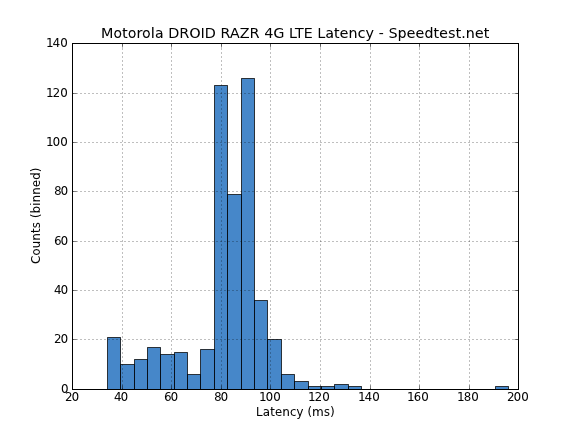
The histograms themselves look a lot like what we’ve seen already out of Verizon’s 4G LTE network on other smartphones, which again uses 10 MHz FDD on LTE band 13. I’ve seen numerous other people hit speeds above 50 Mbps on category 3 devices in favorable network conditions, but obviously the RAZR being category 2 does preclude it hitting those speeds.
Like the Bionic, the RAZR also gives you a nice and easily accessible network option to use either LTE/CDMA or just CDMA. Unfortunately again there’s no way to force data on only LTE and avoid handing over, but in practice I rarely saw the RAZR do a hard handover unless network conditions completely precluded using LTE.
I was pleased with myself when I used the Bionic that it was possible to look at LTE signal power (RSCP) and the channel quality indicator (CQI) by just running logcat and grepping the radio status daemon that Motorola wrote for updating their bar visualization. Unfortunately in this newer version of Blur that logging debug output and functionality is no longer, and if you look closely you’ll also notice they went from 4 bars to 5. There’s another way to view those metrics but it involves having shell on the baseband and directly querying the MIBs that correspond to all the LTE signal quality figures of merit. It’s still possible but much more involved. The upside of course is that I was able to confirm the RAZR correctly reports those bars based on signal power and quality, unlike most of the other LTE handsets which just look at power.
Lastly, the Droid RAZR XT912 Motodev page notes that the phone has WCDMA 850/900/1900/2100 connectivity courtesy of the MDM6600. However, the shipping Droid RAZR has WCDMA disabled and corresponding lines commented out inside build.prop for the WCDMA components. Considering the existence of the RAZR XT910 (sans “Droid”) with WCDMA and GSM I think it’s fairly easy to predict that a world mode variant with LTE is coming sooner rather than later. I wouldn’t mind having a RAZR that works on AT&T WCDMA, that’s for sure.










76 Comments
View All Comments
secretmanofagent - Friday, December 16, 2011 - link
Brian, have you seen any data connectivity issues that plague the Droid Bionic on the RAZR? It was something Verizon confirmed was a known issue (there was a patch released yesterday but don't know if that addressed that issue) and was happening to me quite frequently. I managed to move from the Bionic to the RAZR because of Verizon, and I've seen some hiccups that looked similar to the Bionic issue (it's the same LTE and CDMA baseband).flyfishin69 - Sunday, December 18, 2011 - link
I to am an (almost) former owner of the Bionic. The phone will loose all cellular data after coming in contact with 4g and trying to negotiate back to 3g. And especially in the Hagerstown Md. Area where verizon has no 3g service only 4. I would always find the bionic lifeless. I spoke with a verizon rep and he is sending my Razr tomm. Are we seeing these same problems in the Razr?Nfarce - Sunday, December 18, 2011 - link
Hmmm. I have had the Bionic for three months, since it first came out, and never had a single issue. Here in the greater metro Atlanta area I go between 4G and 3G all the time depending on how far outside the city. I have roamed all over the Southeast while driving and never had a problem either.Sounds to me like you just got a lemon.
secretmanofagent - Monday, December 19, 2011 - link
Nope, they weren't lemons. Check out Verizon's update:http://www.droid-life.com/2011/12/08/droid-bionic-...
Big one is "Improved stability of data connections on 3G and 4G". Worst part for those who still have it: Verizon says it will "help alleviate" the problem.
You're only one of three people that I know of who have said they weren't affected, out of about 10-15. Consider yourself lucky.
Nfarce - Tuesday, December 20, 2011 - link
Yes I guess I was lucky. I actually had no idea this update was even coming until trying to make a call Thursday evening last week. About the only gripe I had of the phone was the crappy autofocus problem. It seems to be a lot better now. I surmise the 3G/4G issue depended at least to some extent what region of the nation you lived in. Two co-workers have the phone (one got a RAZR and gave the Bionic to his wife) and neither reported problems either.secretmanofagent - Monday, December 19, 2011 - link
I've seen a couple times like what I had seen with the Bionic, but only momentary losses.loribeth - Tuesday, December 27, 2011 - link
Both 4G and 3G data drops for me. I live 30 miles north of Indy, which is 3G, but work in 4G territory. The upgrade has not helped and only created other buggy issues.LoneWolf15 - Friday, December 16, 2011 - link
I just did a lot of research before picking up a phone this week. The RAZR was among the half a dozen smartphones I considered --until I picked it up.I have relatively large hands with long fingers, and the phone is STILL too wide to comfortably hold in the hand. It's actually wider than the Droid Bionic (which I did purchase), and its relative thin-ness makes it less comfortable in the hand rather than more. Making a slightly thicker phone, and using that extra thickness to increase battery size would have actually made it more comfortable.
Of course, that would make the phone a Droid Bionic. Which is now $100 cheaper due to the RAZR coming out, so you can save $100 and get a phone that's every bit as capable, with more battery options. They also released a major update to the Bionic this week that squashed a ton of bugs.
At the $299 price, I'd probably look at the Galaxy Nexus or the HTC Rezound --not the RAZR. The Bionic is a much better value if you want a Motorola phone. So far, I'm happy with mine.
Nfarce - Sunday, December 18, 2011 - link
Yep, I like the feel of the Bionic more than the RAZR. I got the thin rubber-like enclosing protective case and it helps even more on the grip. My friend's RAZR feels too fragile and I'd definitely be more worried about dropping it. Thinner isn't always better to some of us.I would have waited for a price drop on the Bionic, but since my older Droid died and I was going month to month without a contract, I had to buy a new phone like yesterday, and in September, the Bionic was the best. Verizon threw in $70 worth of free accessories for me at the full $299 purchase price, so that eased the pain a little (case, car charger, screen protector).
JonnyDough - Saturday, December 17, 2011 - link
"Thankfully holding volume down and power/lock for 10 seconds reboots the device even when the device is totally unresponsive (which I did in fact encounter once)."Something I often encountered on my original DROID and also on my Thunderbolt 4G LTE. I'm honestly a bit sick of the issues with Android. You would think they would fix them. My phone has been known to do some really quirky stuff. From calling people on contact lists from that others who share a phone plan with me have on THEIR phones (the people my phone called are NOT on my phone!), to random reboots, SMS's not sending, and the 3G/4G service acting dodgy, even though I may not leave the house for awhile. Those are just a few of the issues I have suffered through over the last 2 years.